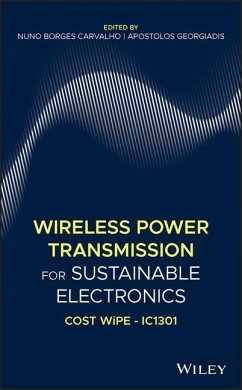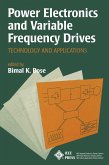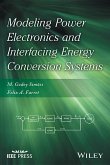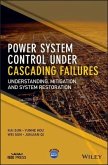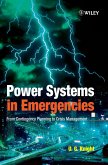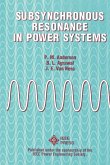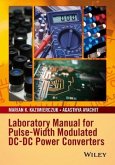Wireless Power Transmission for Sustainable Electronics
Cost Wipe - Ic1301
Herausgeber: Borges Carvalho, Nuno; Georgiadis, Apostolos
Wireless Power Transmission for Sustainable Electronics
Cost Wipe - Ic1301
Herausgeber: Borges Carvalho, Nuno; Georgiadis, Apostolos
- Gebundenes Buch
Andere Kunden interessierten sich auch für
![Power Electronics and Variable Frequency Drives Power Electronics and Variable Frequency Drives]() Power Electronics and Variable Frequency Drives261,99 €
Power Electronics and Variable Frequency Drives261,99 €![Modeling Power Electronics and Interfacing Energy Conversion Systems Modeling Power Electronics and Interfacing Energy Conversion Systems]() M Godoy SimoesModeling Power Electronics and Interfacing Energy Conversion Systems137,99 €
M Godoy SimoesModeling Power Electronics and Interfacing Energy Conversion Systems137,99 €![Power System Control Under Cascading Failures Power System Control Under Cascading Failures]() Kai SunPower System Control Under Cascading Failures177,99 €
Kai SunPower System Control Under Cascading Failures177,99 €![Power Systems in Emergencies Power Systems in Emergencies]() U G KnightPower Systems in Emergencies292,99 €
U G KnightPower Systems in Emergencies292,99 €![Understanding Power Quality Problems Understanding Power Quality Problems]() Math H J BollenUnderstanding Power Quality Problems233,99 €
Math H J BollenUnderstanding Power Quality Problems233,99 €![Subsynchronous Resonance in Power Systems Subsynchronous Resonance in Power Systems]() Paul M AndersonSubsynchronous Resonance in Power Systems188,99 €
Paul M AndersonSubsynchronous Resonance in Power Systems188,99 €![Laboratory Manual for Pulse-Width Modulated DC-DC Power Converters Laboratory Manual for Pulse-Width Modulated DC-DC Power Converters]() Marian K KazimierczukLaboratory Manual for Pulse-Width Modulated DC-DC Power Converters86,99 €
Marian K KazimierczukLaboratory Manual for Pulse-Width Modulated DC-DC Power Converters86,99 €-
-
-
Produktdetails
- Verlag: Wiley
- Seitenzahl: 432
- Erscheinungstermin: 19. Februar 2020
- Englisch
- Abmessung: 231mm x 155mm x 23mm
- Gewicht: 771g
- ISBN-13: 9781119578543
- ISBN-10: 111957854X
- Artikelnr.: 57120259
Hinweis: Dieser Artikel kann nur an eine deutsche Lieferadresse ausgeliefert werden.
- Herstellerkennzeichnung
- Libri GmbH
- Europaallee 1
- 36244 Bad Hersfeld
- gpsr@libri.de
NUNO BORGES CARVALHO, PHD, is a Full Professor at DETI, University of Aveiro, a Senior Research Scientist with the Institute of Telecommunications, and an IEEE Fellow. He is associate editor of the IEEE Microwave Magazine and Cambridge Wireless Power Transfer Journal and former associate editor of the IEEE Transactions on Microwave Theory and Techniques. Dr. Borges Carvalho belongs to the ADCOM of IEEE-MTT and is the Vice-Chair of the URSI Commission A (Metrology Group). APOSTOLOS GEORGIADIS, PHD, is Honorary Associate Professor at Heriot-Watt University, Edinburgh, UK. He is Vice-Chair of EU COST Action IC1301 on Wireless Power Transfer for Sustainable Electronics. He is former Editor-in-Chief of Cambridge Wireless Power Transfer Journal and former Associate Editor of the IEEE Microwave Wireless Components Letters and IET Microwaves Antennas and Propagation journals. He is Chairman of URSI Commission D Electronics and Photonics and a Distinguished Lecturer of IEEE Council on RFID (CRFID).
List of Figures xiii List of Contributors xxxiii Preface xxxvii Acknowledgments xxxix 1 Textile-Supported Wireless Energy Transfer 1 Miroslav Cupal, Jaroslav Lá
ík, Zbyn
k Raida, Jan pürek, and Jan Vélim 1.1 Introduction 1 1.2 Textile-Coated Single-Wire Transmission Line 3 1.3 Textile-Integrated Components 6 1.3.1 Fabrication of the Top Conductive Layer and the Bottom One 8 1.3.2 Fabrication of Conductive Vias of Side Walls 8 1.4 In-Vehicle Wireless Energy Transfer 15 1.5 Summary 24 References 25 2 A Review of Methods for the Electromagnetic Characterization of Textile Materials for the Development of Wearable Antennas 27 Caroline Loss, Ricardo Gonçalves, Pedro Pinho, and Rita Salvado 2.1 Introduction 27 2.2 Electromagnetic Properties of Materials 29 2.2.1 Conductive Fabrics 29 2.2.2 Dielectric Fabrics 31 2.3 Dielectric Characterization Methods Applied to Textile Materials and Leather: A Survey 32 2.3.1 Resonant Methods 33 2.3.1.1 Cavity Perturbation Methods 33 2.3.1.2 Microstrip Resonator Patch Method 35 2.3.1.3 Microstrip Resonator Ring Method 35 2.3.1.4 Microstrip Patch Sensor 35 2.3.1.5 Agilent 85070E Dielectric Measurement Probe Kit 39 2.3.1.6 Summary of the Characterization of Textile Materials by Resonant Methods 40 2.3.2 Nonresonant Methods 40 2.3.2.1 Parallel Plate Method 40 2.3.2.2 Free Space Methods 41 2.3.2.3 Planar Transmission Lines Methods 44 2.3.2.4 Summary of the Characterization of Textile Materials by Nonresonant Methods 46 2.4 Some Factors that Affect the Measurement of Dielectric Properties of Textiles 46 2.4.1 Influence of the Moisture Content 46 2.4.2 Influence of the Material Anisotropy 47 2.4.3 Influence of the Bulk Porosity 47 2.4.4 Influence of the Surface Features 48 2.5 Conclusions 48 Acknowledgments 50 References 50 3 Smart Beamforming Techniques for "On Demand" WPT 57 Diego Masotti, Mazen Shanawani, and Alessandra Costanzo 3.1 Introduction 57 3.2 Basics of Time-modulated Arrays 61 3.3 Nonlinear/Full-Wave Co-simulation of TMAS 63 3.4 Two-Step Agile WPT Strategy 64 3.4.1 Localization Step 65 3.4.2 Power Transfer Step 66 3.5 Simulation Results 68 3.5.1 Localization Step 68 3.5.2 Power Transfer Step 69 3.6 Measured Results 73 3.7 TMA Architecture for Fundamental Pattern Steering 76 3.8 Conclusion 81 References 82 4 Backscatter a Solution for IoT Devices 85 Daniel Belo, Ricardo Correia, Marina Jordao, Pedro Pinho, and Nuno B. Carvalho 4.1 Backscatter Basics 85 4.1.1 Different Backscatter Sensors Development 87 4.1.2 Backscatter with WPT Capabilities 87 4.1.3 High-Order Backscatter Modulation 88 4.1.4 Modulated High-Bandwidth Backscatter with WPT Capabilities 89 4.2 An IoT-Complete Sensor with Backscatter Capabilities 90 4.2.1 System Description 91 4.2.2 Digital Component 92 4.2.3 Measurements 94 4.3 The Power Availability for These Sensors 97 4.3.1 Electronically Steerable Phased Array for Wireless Power Transfer Applications 98 4.3.2 Wireless Energy Receiving Device 101 4.3.3 Experimental Results 104 4.4 Characterization of High-Order Modulation Backscatter Systems 107 4.4.1 Characterization System 107 4.4.2 Measurements 110 References 114 5 Ambient FM Backscattering Low-Cost and Low-Power Wireless RFID Applications 117 Spyridon N. Daskalakis, Ricardo Correia, John Kimionis, George Goussetis, Manos M. Tentzeris, Nuno B. Carvalho, and Apostolos Georgiadis 5.1 Introduction 117 5.2 Ambient Backscattering 120 5.2.1 Ambient FM Backscattering 122 5.2.2 Binary Modulation Tag 124 5.2.3 4-PAM Tag 125 5.2.4 Binary Telecommunication Protocol 127 5.2.5 4-PAM Telecommunication Protocol 129 5.2.6 Receiver 129 5.2.7 Software Binary Receiver 130 5.2.8 Software 4-PAM Receiver 132 5.2.9 Experimental and Measurement Results 132 5.3 Conclusions 138 Acknowledgments 139 References 139 6 Backscatter RFID Sensor System for Remote Health Monitoring 145 Jasmin Grosinger 6.1 Introduction 145 6.2 On-Body System 146 6.2.1 Body Model 146 6.2.2 Antennas 149 6.2.2.1 Monopole Antennas 149 6.2.2.2 Patch Antennas 151 6.3 Radio Channel 152 6.3.1 Measurement Setup 153 6.3.2 Comparison of Simulations and Measurements 154 6.3.3 Measurement Results 156 6.3.3.1 Antenna Matching 156 6.3.3.2 Channel Gain 157 6.4 System Performance 159 6.4.1 Forward Link 162 6.4.1.1 System Example 165 6.4.2 Backward Link 166 6.4.2.1 System Example 166 6.5 Conclusions 168 Acknowledgments 169 References 170 7 Robotics Meets RFID for Simultaneous Localization (of Robots and Objects) and Mapping (SLAM) - A Joined Problem 175 Antonis G. Dimitriou, Stavroula Siachalou, Emmanouil Tsardoulias, and Loukas Petrou 7.1 Scope 175 7.2 Introduction 176 7.3 Localization of RFID Tags - Prior Art 182 7.3.1 Multipath in Passive RFID Systems 184 7.3.2 Representative Localization Techniques 185 7.3.2.1 Angle of Arrival 185 7.3.2.2 Received Signal Strength - Bayes' Theorem and Conditional Probability 187 7.3.2.3 Fingerprinting - "Landmarc" 189 7.3.2.4 Holographic Localization 190 7.3.2.5 Other Methods 192 7.3.3 Analysis of Prior Art 194 7.4 A Brief Introduction in SLAM/Localization Techniques 195 7.4.1 Introduction to Localization, Mapping, and SLAM 196 7.4.2 Mathematical Formulation of SLAM 197 7.4.3 Probabilistically Solving SLAM 198 7.4.4 Space Representation in SLAM 201 7.4.5 SLAM Algorithm Selection 202 7.4.5.1 What are the Robot's Sensors? 202 7.4.5.2 Which is the Environmental Morphology? 203 7.4.5.3 How Will the Generated Map Be Utilized? 203 7.4.6 SLAM/Localization and RFID Localization Issues 204 7.5 Prototype - Experimental Results 206 7.5.1 Equipment 206 7.5.2 Methodology 208 7.5.2.1 Phase 1 208 7.5.2.2 Phase 2 209 7.5.3 Results 212 7.6 Discussion 216 Acknowledgments 218 References 218 8 From Identification to Sensing: Augmented RFID Tags 223 Konstantinos Zannas, Hatem El Matbouly, Yvan Duroc, and Smail Tedjini 8.1 Introduction 223 8.2 Generic RFID Communication Chain 226 8.2.1 RFID Sensor Tag 226 8.2.2 RFID Data Capture Level 228 8.2.3 RFID Tag Process Level 229 8.2.4 RFID Communication Channel 231 8.2.5 RFID Reader Process Level and RFID Reader 232 8.3 RFID Sensor Tags: Examples from Literature or Commercially Available 233 8.3.1 Examples from Literature 234 8.3.2 Examples Commercially Available 239 8.4 Comparison of Different Types of RFID Temperature Sensors 240 8.5 Conclusion 242 References 243 9 Autonomous System of Wireless Power Distribution for Static and Moving Nodes of Wireless Sensor Networks 247 Przemyslaw Kant, Karol Dobrzyniewicz, and Jerzy Julian Michalski 9.1 Introduction 247 9.2 Data Routing in WSN Based on Multiple Spanning Trees Concept 248 9.2.1 Multiple Spanning Trees Routing Protocol 249 9.2.2 Software WSN Simulator 252 9.2.3 Experimental Verification 253 9.3 WPT System for 2D Distributed WSN 256 9.3.1 System Concept 257 9.3.2 Physical Realization of 2D WPT System 260 9.3.3 Experimental Verification of the 2DWPT System 264 9.3.4 Tests of 2D WPT System with Implemented Switching Algorithm 266 9.4 WPT System for 3D Distributed WSN 269 9.4.1 Design of Components of the 3D WPT System 272 9.5 Locating System and Electromagnetic Power Supply for WSN in 3D Space 275 9.5.1 Tracking Subsystem 276 9.5.2 Data Exchange System 278 9.5.3 Angular Position Estimation of Moving WSN Node 279 9.5.4 Experimental Verification 281 9.5.5 Adaptation of the System to WPT for WSN 282 9.5.5.1 Tracking System 282 9.5.5.2 WSN Node 282 9.6 Summary 283 References 284 10 Smartphone Reception of Microwatt, Meter to Kilometer Range Backscatter Resistive/Capacitive Sensors with Ambient FM Remodulation and Selection Diversity 287 Georgios Vougioukas and Aggelos Bletsas 10.1 Introduction 287 10.2 Operating Principle 291 10.2.1 Backscatter Communication 291 10.2.2 FM Remodulation 292 10.3 Impact of Noise 293 10.3.1 High SNR Case 294 10.3.2 Low SNR Case 301 10.4 Occupied Bandwidth 302 10.5 Ambient Selection Diversity 303 10.6 Analog Tag Implementation 304 10.6.1 Sensing Capacitor and Control Circuit 305 10.6.1.1 Generating
(t) - First Modulation Level 305 10.6.1.2 Generating xFM(t) - Second Modulation Level 306 10.6.2 RF-Switch 306 10.6.3 Power Consumption and Supply 306 10.6.3.1 Batteryless Tag with Photodiode 307 10.6.3.2 Batteryless Tag with Solar Panel 307 10.6.3.3 Batteryless Tag with Lemons 307 10.6.4 Receiver 308 10.6.4.1 Smartphone 308 10.6.4.2 Computer 309 10.7 Performance Characterization 309 10.7.1 Simulation Results 309 10.7.2 Tag Indoor and Outdoor Performance 312 10.8 Conclusions 313 10.9 Bandwidth of J0 (2
sin (
sens/2 t)) 314 10.10 Expectation of the Absolute Value of a Gaussian R.V 316 10.11 Probability of Outage Under Ambient Selection Diversity 316 Acknowledgment 318 References 318 11 Design of an ULP-ULV RF-Powered CMOS Front-End for Low-Rate Autonomous Sensors 323 Hugo García-Vázquez, Alexandre Quenon, Grigory Popov, and Fortunato Carlos Dualibe 11.1 Introduction 323 11.2 Characterization of the Technology 326 11.2.1 gm/ID Curves 326 11.2.2 COX and
COX 329 11.2.3 Early Voltage (VA) 331 11.3 Ultra-Low Power and Ultra-Low Voltage RF-Powered Transceiver for Autonomous Sensors 332 11.3.1 Power Management (PM) and Receiver (RX) 332 11.3.1.1 Rectifier 333 11.3.1.2 Voltage Reference (VREF) Circuit 335 11.3.1.3 Comparator for Power Management (COMP1) 335 11.3.1.4 Current Reference Circuit (IREF) 336 11.3.1.5 Comparator for the Demodulation (COMP2) 336 11.3.2 Control Unit (CU) 336 11.3.3 Transmitter (TX) 337 11.3.3.1 Voltage-controlled oscillator (VCO) 337 11.3.3.2 Power amplifier (PA) with built-in driver 340 11.4 Experimental Results 341 11.5 Conclusion 343 Acknowledgments 343 References 344 12 Rectenna Optimization Guidelines for Ambient Electromagnetic Energy Harvesting 347 Erika Vandelle, Simon Hemour, Tan-Phu Vuong, Gustavo Ardila, and Ke Wu 12.1 Introduction 347 12.2 Rectennas Under Low Input Powers 348 12.2.1 Rectifier Optimization 350 12.2.2 Low Power Matching Network Optimization 353 12.2.2.1 The Bode-Fano Criterion 353 12.2.2.2 Matching Network Efficiency 354 12.2.3 Low-Power Antenna Optimization 356 12.2.3.1 Enhancement of the Output DC Power 357 12.2.3.2 Rectenna Array 358 12.2.3.3 Antenna Array with BFN 358 12.2.3.4 Optimization of the Antenna Efficiency 361 12.3 The Chance of Collecting Ambient Electromagnetic Energy with a Specific Antenna 361 12.3.1 Frequency Spectrum 362 12.3.2 Polarization 362 12.3.3 Spatial Coverage 365 12.3.4 Harvesting Capability 366 12.4 Conclusion 367 References 368 Index 375
ík, Zbyn
k Raida, Jan pürek, and Jan Vélim 1.1 Introduction 1 1.2 Textile-Coated Single-Wire Transmission Line 3 1.3 Textile-Integrated Components 6 1.3.1 Fabrication of the Top Conductive Layer and the Bottom One 8 1.3.2 Fabrication of Conductive Vias of Side Walls 8 1.4 In-Vehicle Wireless Energy Transfer 15 1.5 Summary 24 References 25 2 A Review of Methods for the Electromagnetic Characterization of Textile Materials for the Development of Wearable Antennas 27 Caroline Loss, Ricardo Gonçalves, Pedro Pinho, and Rita Salvado 2.1 Introduction 27 2.2 Electromagnetic Properties of Materials 29 2.2.1 Conductive Fabrics 29 2.2.2 Dielectric Fabrics 31 2.3 Dielectric Characterization Methods Applied to Textile Materials and Leather: A Survey 32 2.3.1 Resonant Methods 33 2.3.1.1 Cavity Perturbation Methods 33 2.3.1.2 Microstrip Resonator Patch Method 35 2.3.1.3 Microstrip Resonator Ring Method 35 2.3.1.4 Microstrip Patch Sensor 35 2.3.1.5 Agilent 85070E Dielectric Measurement Probe Kit 39 2.3.1.6 Summary of the Characterization of Textile Materials by Resonant Methods 40 2.3.2 Nonresonant Methods 40 2.3.2.1 Parallel Plate Method 40 2.3.2.2 Free Space Methods 41 2.3.2.3 Planar Transmission Lines Methods 44 2.3.2.4 Summary of the Characterization of Textile Materials by Nonresonant Methods 46 2.4 Some Factors that Affect the Measurement of Dielectric Properties of Textiles 46 2.4.1 Influence of the Moisture Content 46 2.4.2 Influence of the Material Anisotropy 47 2.4.3 Influence of the Bulk Porosity 47 2.4.4 Influence of the Surface Features 48 2.5 Conclusions 48 Acknowledgments 50 References 50 3 Smart Beamforming Techniques for "On Demand" WPT 57 Diego Masotti, Mazen Shanawani, and Alessandra Costanzo 3.1 Introduction 57 3.2 Basics of Time-modulated Arrays 61 3.3 Nonlinear/Full-Wave Co-simulation of TMAS 63 3.4 Two-Step Agile WPT Strategy 64 3.4.1 Localization Step 65 3.4.2 Power Transfer Step 66 3.5 Simulation Results 68 3.5.1 Localization Step 68 3.5.2 Power Transfer Step 69 3.6 Measured Results 73 3.7 TMA Architecture for Fundamental Pattern Steering 76 3.8 Conclusion 81 References 82 4 Backscatter a Solution for IoT Devices 85 Daniel Belo, Ricardo Correia, Marina Jordao, Pedro Pinho, and Nuno B. Carvalho 4.1 Backscatter Basics 85 4.1.1 Different Backscatter Sensors Development 87 4.1.2 Backscatter with WPT Capabilities 87 4.1.3 High-Order Backscatter Modulation 88 4.1.4 Modulated High-Bandwidth Backscatter with WPT Capabilities 89 4.2 An IoT-Complete Sensor with Backscatter Capabilities 90 4.2.1 System Description 91 4.2.2 Digital Component 92 4.2.3 Measurements 94 4.3 The Power Availability for These Sensors 97 4.3.1 Electronically Steerable Phased Array for Wireless Power Transfer Applications 98 4.3.2 Wireless Energy Receiving Device 101 4.3.3 Experimental Results 104 4.4 Characterization of High-Order Modulation Backscatter Systems 107 4.4.1 Characterization System 107 4.4.2 Measurements 110 References 114 5 Ambient FM Backscattering Low-Cost and Low-Power Wireless RFID Applications 117 Spyridon N. Daskalakis, Ricardo Correia, John Kimionis, George Goussetis, Manos M. Tentzeris, Nuno B. Carvalho, and Apostolos Georgiadis 5.1 Introduction 117 5.2 Ambient Backscattering 120 5.2.1 Ambient FM Backscattering 122 5.2.2 Binary Modulation Tag 124 5.2.3 4-PAM Tag 125 5.2.4 Binary Telecommunication Protocol 127 5.2.5 4-PAM Telecommunication Protocol 129 5.2.6 Receiver 129 5.2.7 Software Binary Receiver 130 5.2.8 Software 4-PAM Receiver 132 5.2.9 Experimental and Measurement Results 132 5.3 Conclusions 138 Acknowledgments 139 References 139 6 Backscatter RFID Sensor System for Remote Health Monitoring 145 Jasmin Grosinger 6.1 Introduction 145 6.2 On-Body System 146 6.2.1 Body Model 146 6.2.2 Antennas 149 6.2.2.1 Monopole Antennas 149 6.2.2.2 Patch Antennas 151 6.3 Radio Channel 152 6.3.1 Measurement Setup 153 6.3.2 Comparison of Simulations and Measurements 154 6.3.3 Measurement Results 156 6.3.3.1 Antenna Matching 156 6.3.3.2 Channel Gain 157 6.4 System Performance 159 6.4.1 Forward Link 162 6.4.1.1 System Example 165 6.4.2 Backward Link 166 6.4.2.1 System Example 166 6.5 Conclusions 168 Acknowledgments 169 References 170 7 Robotics Meets RFID for Simultaneous Localization (of Robots and Objects) and Mapping (SLAM) - A Joined Problem 175 Antonis G. Dimitriou, Stavroula Siachalou, Emmanouil Tsardoulias, and Loukas Petrou 7.1 Scope 175 7.2 Introduction 176 7.3 Localization of RFID Tags - Prior Art 182 7.3.1 Multipath in Passive RFID Systems 184 7.3.2 Representative Localization Techniques 185 7.3.2.1 Angle of Arrival 185 7.3.2.2 Received Signal Strength - Bayes' Theorem and Conditional Probability 187 7.3.2.3 Fingerprinting - "Landmarc" 189 7.3.2.4 Holographic Localization 190 7.3.2.5 Other Methods 192 7.3.3 Analysis of Prior Art 194 7.4 A Brief Introduction in SLAM/Localization Techniques 195 7.4.1 Introduction to Localization, Mapping, and SLAM 196 7.4.2 Mathematical Formulation of SLAM 197 7.4.3 Probabilistically Solving SLAM 198 7.4.4 Space Representation in SLAM 201 7.4.5 SLAM Algorithm Selection 202 7.4.5.1 What are the Robot's Sensors? 202 7.4.5.2 Which is the Environmental Morphology? 203 7.4.5.3 How Will the Generated Map Be Utilized? 203 7.4.6 SLAM/Localization and RFID Localization Issues 204 7.5 Prototype - Experimental Results 206 7.5.1 Equipment 206 7.5.2 Methodology 208 7.5.2.1 Phase 1 208 7.5.2.2 Phase 2 209 7.5.3 Results 212 7.6 Discussion 216 Acknowledgments 218 References 218 8 From Identification to Sensing: Augmented RFID Tags 223 Konstantinos Zannas, Hatem El Matbouly, Yvan Duroc, and Smail Tedjini 8.1 Introduction 223 8.2 Generic RFID Communication Chain 226 8.2.1 RFID Sensor Tag 226 8.2.2 RFID Data Capture Level 228 8.2.3 RFID Tag Process Level 229 8.2.4 RFID Communication Channel 231 8.2.5 RFID Reader Process Level and RFID Reader 232 8.3 RFID Sensor Tags: Examples from Literature or Commercially Available 233 8.3.1 Examples from Literature 234 8.3.2 Examples Commercially Available 239 8.4 Comparison of Different Types of RFID Temperature Sensors 240 8.5 Conclusion 242 References 243 9 Autonomous System of Wireless Power Distribution for Static and Moving Nodes of Wireless Sensor Networks 247 Przemyslaw Kant, Karol Dobrzyniewicz, and Jerzy Julian Michalski 9.1 Introduction 247 9.2 Data Routing in WSN Based on Multiple Spanning Trees Concept 248 9.2.1 Multiple Spanning Trees Routing Protocol 249 9.2.2 Software WSN Simulator 252 9.2.3 Experimental Verification 253 9.3 WPT System for 2D Distributed WSN 256 9.3.1 System Concept 257 9.3.2 Physical Realization of 2D WPT System 260 9.3.3 Experimental Verification of the 2DWPT System 264 9.3.4 Tests of 2D WPT System with Implemented Switching Algorithm 266 9.4 WPT System for 3D Distributed WSN 269 9.4.1 Design of Components of the 3D WPT System 272 9.5 Locating System and Electromagnetic Power Supply for WSN in 3D Space 275 9.5.1 Tracking Subsystem 276 9.5.2 Data Exchange System 278 9.5.3 Angular Position Estimation of Moving WSN Node 279 9.5.4 Experimental Verification 281 9.5.5 Adaptation of the System to WPT for WSN 282 9.5.5.1 Tracking System 282 9.5.5.2 WSN Node 282 9.6 Summary 283 References 284 10 Smartphone Reception of Microwatt, Meter to Kilometer Range Backscatter Resistive/Capacitive Sensors with Ambient FM Remodulation and Selection Diversity 287 Georgios Vougioukas and Aggelos Bletsas 10.1 Introduction 287 10.2 Operating Principle 291 10.2.1 Backscatter Communication 291 10.2.2 FM Remodulation 292 10.3 Impact of Noise 293 10.3.1 High SNR Case 294 10.3.2 Low SNR Case 301 10.4 Occupied Bandwidth 302 10.5 Ambient Selection Diversity 303 10.6 Analog Tag Implementation 304 10.6.1 Sensing Capacitor and Control Circuit 305 10.6.1.1 Generating
(t) - First Modulation Level 305 10.6.1.2 Generating xFM(t) - Second Modulation Level 306 10.6.2 RF-Switch 306 10.6.3 Power Consumption and Supply 306 10.6.3.1 Batteryless Tag with Photodiode 307 10.6.3.2 Batteryless Tag with Solar Panel 307 10.6.3.3 Batteryless Tag with Lemons 307 10.6.4 Receiver 308 10.6.4.1 Smartphone 308 10.6.4.2 Computer 309 10.7 Performance Characterization 309 10.7.1 Simulation Results 309 10.7.2 Tag Indoor and Outdoor Performance 312 10.8 Conclusions 313 10.9 Bandwidth of J0 (2
sin (
sens/2 t)) 314 10.10 Expectation of the Absolute Value of a Gaussian R.V 316 10.11 Probability of Outage Under Ambient Selection Diversity 316 Acknowledgment 318 References 318 11 Design of an ULP-ULV RF-Powered CMOS Front-End for Low-Rate Autonomous Sensors 323 Hugo García-Vázquez, Alexandre Quenon, Grigory Popov, and Fortunato Carlos Dualibe 11.1 Introduction 323 11.2 Characterization of the Technology 326 11.2.1 gm/ID Curves 326 11.2.2 COX and
COX 329 11.2.3 Early Voltage (VA) 331 11.3 Ultra-Low Power and Ultra-Low Voltage RF-Powered Transceiver for Autonomous Sensors 332 11.3.1 Power Management (PM) and Receiver (RX) 332 11.3.1.1 Rectifier 333 11.3.1.2 Voltage Reference (VREF) Circuit 335 11.3.1.3 Comparator for Power Management (COMP1) 335 11.3.1.4 Current Reference Circuit (IREF) 336 11.3.1.5 Comparator for the Demodulation (COMP2) 336 11.3.2 Control Unit (CU) 336 11.3.3 Transmitter (TX) 337 11.3.3.1 Voltage-controlled oscillator (VCO) 337 11.3.3.2 Power amplifier (PA) with built-in driver 340 11.4 Experimental Results 341 11.5 Conclusion 343 Acknowledgments 343 References 344 12 Rectenna Optimization Guidelines for Ambient Electromagnetic Energy Harvesting 347 Erika Vandelle, Simon Hemour, Tan-Phu Vuong, Gustavo Ardila, and Ke Wu 12.1 Introduction 347 12.2 Rectennas Under Low Input Powers 348 12.2.1 Rectifier Optimization 350 12.2.2 Low Power Matching Network Optimization 353 12.2.2.1 The Bode-Fano Criterion 353 12.2.2.2 Matching Network Efficiency 354 12.2.3 Low-Power Antenna Optimization 356 12.2.3.1 Enhancement of the Output DC Power 357 12.2.3.2 Rectenna Array 358 12.2.3.3 Antenna Array with BFN 358 12.2.3.4 Optimization of the Antenna Efficiency 361 12.3 The Chance of Collecting Ambient Electromagnetic Energy with a Specific Antenna 361 12.3.1 Frequency Spectrum 362 12.3.2 Polarization 362 12.3.3 Spatial Coverage 365 12.3.4 Harvesting Capability 366 12.4 Conclusion 367 References 368 Index 375
List of Figures xiii List of Contributors xxxiii Preface xxxvii Acknowledgments xxxix 1 Textile-Supported Wireless Energy Transfer 1 Miroslav Cupal, Jaroslav Lá
ík, Zbyn
k Raida, Jan pürek, and Jan Vélim 1.1 Introduction 1 1.2 Textile-Coated Single-Wire Transmission Line 3 1.3 Textile-Integrated Components 6 1.3.1 Fabrication of the Top Conductive Layer and the Bottom One 8 1.3.2 Fabrication of Conductive Vias of Side Walls 8 1.4 In-Vehicle Wireless Energy Transfer 15 1.5 Summary 24 References 25 2 A Review of Methods for the Electromagnetic Characterization of Textile Materials for the Development of Wearable Antennas 27 Caroline Loss, Ricardo Gonçalves, Pedro Pinho, and Rita Salvado 2.1 Introduction 27 2.2 Electromagnetic Properties of Materials 29 2.2.1 Conductive Fabrics 29 2.2.2 Dielectric Fabrics 31 2.3 Dielectric Characterization Methods Applied to Textile Materials and Leather: A Survey 32 2.3.1 Resonant Methods 33 2.3.1.1 Cavity Perturbation Methods 33 2.3.1.2 Microstrip Resonator Patch Method 35 2.3.1.3 Microstrip Resonator Ring Method 35 2.3.1.4 Microstrip Patch Sensor 35 2.3.1.5 Agilent 85070E Dielectric Measurement Probe Kit 39 2.3.1.6 Summary of the Characterization of Textile Materials by Resonant Methods 40 2.3.2 Nonresonant Methods 40 2.3.2.1 Parallel Plate Method 40 2.3.2.2 Free Space Methods 41 2.3.2.3 Planar Transmission Lines Methods 44 2.3.2.4 Summary of the Characterization of Textile Materials by Nonresonant Methods 46 2.4 Some Factors that Affect the Measurement of Dielectric Properties of Textiles 46 2.4.1 Influence of the Moisture Content 46 2.4.2 Influence of the Material Anisotropy 47 2.4.3 Influence of the Bulk Porosity 47 2.4.4 Influence of the Surface Features 48 2.5 Conclusions 48 Acknowledgments 50 References 50 3 Smart Beamforming Techniques for "On Demand" WPT 57 Diego Masotti, Mazen Shanawani, and Alessandra Costanzo 3.1 Introduction 57 3.2 Basics of Time-modulated Arrays 61 3.3 Nonlinear/Full-Wave Co-simulation of TMAS 63 3.4 Two-Step Agile WPT Strategy 64 3.4.1 Localization Step 65 3.4.2 Power Transfer Step 66 3.5 Simulation Results 68 3.5.1 Localization Step 68 3.5.2 Power Transfer Step 69 3.6 Measured Results 73 3.7 TMA Architecture for Fundamental Pattern Steering 76 3.8 Conclusion 81 References 82 4 Backscatter a Solution for IoT Devices 85 Daniel Belo, Ricardo Correia, Marina Jordao, Pedro Pinho, and Nuno B. Carvalho 4.1 Backscatter Basics 85 4.1.1 Different Backscatter Sensors Development 87 4.1.2 Backscatter with WPT Capabilities 87 4.1.3 High-Order Backscatter Modulation 88 4.1.4 Modulated High-Bandwidth Backscatter with WPT Capabilities 89 4.2 An IoT-Complete Sensor with Backscatter Capabilities 90 4.2.1 System Description 91 4.2.2 Digital Component 92 4.2.3 Measurements 94 4.3 The Power Availability for These Sensors 97 4.3.1 Electronically Steerable Phased Array for Wireless Power Transfer Applications 98 4.3.2 Wireless Energy Receiving Device 101 4.3.3 Experimental Results 104 4.4 Characterization of High-Order Modulation Backscatter Systems 107 4.4.1 Characterization System 107 4.4.2 Measurements 110 References 114 5 Ambient FM Backscattering Low-Cost and Low-Power Wireless RFID Applications 117 Spyridon N. Daskalakis, Ricardo Correia, John Kimionis, George Goussetis, Manos M. Tentzeris, Nuno B. Carvalho, and Apostolos Georgiadis 5.1 Introduction 117 5.2 Ambient Backscattering 120 5.2.1 Ambient FM Backscattering 122 5.2.2 Binary Modulation Tag 124 5.2.3 4-PAM Tag 125 5.2.4 Binary Telecommunication Protocol 127 5.2.5 4-PAM Telecommunication Protocol 129 5.2.6 Receiver 129 5.2.7 Software Binary Receiver 130 5.2.8 Software 4-PAM Receiver 132 5.2.9 Experimental and Measurement Results 132 5.3 Conclusions 138 Acknowledgments 139 References 139 6 Backscatter RFID Sensor System for Remote Health Monitoring 145 Jasmin Grosinger 6.1 Introduction 145 6.2 On-Body System 146 6.2.1 Body Model 146 6.2.2 Antennas 149 6.2.2.1 Monopole Antennas 149 6.2.2.2 Patch Antennas 151 6.3 Radio Channel 152 6.3.1 Measurement Setup 153 6.3.2 Comparison of Simulations and Measurements 154 6.3.3 Measurement Results 156 6.3.3.1 Antenna Matching 156 6.3.3.2 Channel Gain 157 6.4 System Performance 159 6.4.1 Forward Link 162 6.4.1.1 System Example 165 6.4.2 Backward Link 166 6.4.2.1 System Example 166 6.5 Conclusions 168 Acknowledgments 169 References 170 7 Robotics Meets RFID for Simultaneous Localization (of Robots and Objects) and Mapping (SLAM) - A Joined Problem 175 Antonis G. Dimitriou, Stavroula Siachalou, Emmanouil Tsardoulias, and Loukas Petrou 7.1 Scope 175 7.2 Introduction 176 7.3 Localization of RFID Tags - Prior Art 182 7.3.1 Multipath in Passive RFID Systems 184 7.3.2 Representative Localization Techniques 185 7.3.2.1 Angle of Arrival 185 7.3.2.2 Received Signal Strength - Bayes' Theorem and Conditional Probability 187 7.3.2.3 Fingerprinting - "Landmarc" 189 7.3.2.4 Holographic Localization 190 7.3.2.5 Other Methods 192 7.3.3 Analysis of Prior Art 194 7.4 A Brief Introduction in SLAM/Localization Techniques 195 7.4.1 Introduction to Localization, Mapping, and SLAM 196 7.4.2 Mathematical Formulation of SLAM 197 7.4.3 Probabilistically Solving SLAM 198 7.4.4 Space Representation in SLAM 201 7.4.5 SLAM Algorithm Selection 202 7.4.5.1 What are the Robot's Sensors? 202 7.4.5.2 Which is the Environmental Morphology? 203 7.4.5.3 How Will the Generated Map Be Utilized? 203 7.4.6 SLAM/Localization and RFID Localization Issues 204 7.5 Prototype - Experimental Results 206 7.5.1 Equipment 206 7.5.2 Methodology 208 7.5.2.1 Phase 1 208 7.5.2.2 Phase 2 209 7.5.3 Results 212 7.6 Discussion 216 Acknowledgments 218 References 218 8 From Identification to Sensing: Augmented RFID Tags 223 Konstantinos Zannas, Hatem El Matbouly, Yvan Duroc, and Smail Tedjini 8.1 Introduction 223 8.2 Generic RFID Communication Chain 226 8.2.1 RFID Sensor Tag 226 8.2.2 RFID Data Capture Level 228 8.2.3 RFID Tag Process Level 229 8.2.4 RFID Communication Channel 231 8.2.5 RFID Reader Process Level and RFID Reader 232 8.3 RFID Sensor Tags: Examples from Literature or Commercially Available 233 8.3.1 Examples from Literature 234 8.3.2 Examples Commercially Available 239 8.4 Comparison of Different Types of RFID Temperature Sensors 240 8.5 Conclusion 242 References 243 9 Autonomous System of Wireless Power Distribution for Static and Moving Nodes of Wireless Sensor Networks 247 Przemyslaw Kant, Karol Dobrzyniewicz, and Jerzy Julian Michalski 9.1 Introduction 247 9.2 Data Routing in WSN Based on Multiple Spanning Trees Concept 248 9.2.1 Multiple Spanning Trees Routing Protocol 249 9.2.2 Software WSN Simulator 252 9.2.3 Experimental Verification 253 9.3 WPT System for 2D Distributed WSN 256 9.3.1 System Concept 257 9.3.2 Physical Realization of 2D WPT System 260 9.3.3 Experimental Verification of the 2DWPT System 264 9.3.4 Tests of 2D WPT System with Implemented Switching Algorithm 266 9.4 WPT System for 3D Distributed WSN 269 9.4.1 Design of Components of the 3D WPT System 272 9.5 Locating System and Electromagnetic Power Supply for WSN in 3D Space 275 9.5.1 Tracking Subsystem 276 9.5.2 Data Exchange System 278 9.5.3 Angular Position Estimation of Moving WSN Node 279 9.5.4 Experimental Verification 281 9.5.5 Adaptation of the System to WPT for WSN 282 9.5.5.1 Tracking System 282 9.5.5.2 WSN Node 282 9.6 Summary 283 References 284 10 Smartphone Reception of Microwatt, Meter to Kilometer Range Backscatter Resistive/Capacitive Sensors with Ambient FM Remodulation and Selection Diversity 287 Georgios Vougioukas and Aggelos Bletsas 10.1 Introduction 287 10.2 Operating Principle 291 10.2.1 Backscatter Communication 291 10.2.2 FM Remodulation 292 10.3 Impact of Noise 293 10.3.1 High SNR Case 294 10.3.2 Low SNR Case 301 10.4 Occupied Bandwidth 302 10.5 Ambient Selection Diversity 303 10.6 Analog Tag Implementation 304 10.6.1 Sensing Capacitor and Control Circuit 305 10.6.1.1 Generating
(t) - First Modulation Level 305 10.6.1.2 Generating xFM(t) - Second Modulation Level 306 10.6.2 RF-Switch 306 10.6.3 Power Consumption and Supply 306 10.6.3.1 Batteryless Tag with Photodiode 307 10.6.3.2 Batteryless Tag with Solar Panel 307 10.6.3.3 Batteryless Tag with Lemons 307 10.6.4 Receiver 308 10.6.4.1 Smartphone 308 10.6.4.2 Computer 309 10.7 Performance Characterization 309 10.7.1 Simulation Results 309 10.7.2 Tag Indoor and Outdoor Performance 312 10.8 Conclusions 313 10.9 Bandwidth of J0 (2
sin (
sens/2 t)) 314 10.10 Expectation of the Absolute Value of a Gaussian R.V 316 10.11 Probability of Outage Under Ambient Selection Diversity 316 Acknowledgment 318 References 318 11 Design of an ULP-ULV RF-Powered CMOS Front-End for Low-Rate Autonomous Sensors 323 Hugo García-Vázquez, Alexandre Quenon, Grigory Popov, and Fortunato Carlos Dualibe 11.1 Introduction 323 11.2 Characterization of the Technology 326 11.2.1 gm/ID Curves 326 11.2.2 COX and
COX 329 11.2.3 Early Voltage (VA) 331 11.3 Ultra-Low Power and Ultra-Low Voltage RF-Powered Transceiver for Autonomous Sensors 332 11.3.1 Power Management (PM) and Receiver (RX) 332 11.3.1.1 Rectifier 333 11.3.1.2 Voltage Reference (VREF) Circuit 335 11.3.1.3 Comparator for Power Management (COMP1) 335 11.3.1.4 Current Reference Circuit (IREF) 336 11.3.1.5 Comparator for the Demodulation (COMP2) 336 11.3.2 Control Unit (CU) 336 11.3.3 Transmitter (TX) 337 11.3.3.1 Voltage-controlled oscillator (VCO) 337 11.3.3.2 Power amplifier (PA) with built-in driver 340 11.4 Experimental Results 341 11.5 Conclusion 343 Acknowledgments 343 References 344 12 Rectenna Optimization Guidelines for Ambient Electromagnetic Energy Harvesting 347 Erika Vandelle, Simon Hemour, Tan-Phu Vuong, Gustavo Ardila, and Ke Wu 12.1 Introduction 347 12.2 Rectennas Under Low Input Powers 348 12.2.1 Rectifier Optimization 350 12.2.2 Low Power Matching Network Optimization 353 12.2.2.1 The Bode-Fano Criterion 353 12.2.2.2 Matching Network Efficiency 354 12.2.3 Low-Power Antenna Optimization 356 12.2.3.1 Enhancement of the Output DC Power 357 12.2.3.2 Rectenna Array 358 12.2.3.3 Antenna Array with BFN 358 12.2.3.4 Optimization of the Antenna Efficiency 361 12.3 The Chance of Collecting Ambient Electromagnetic Energy with a Specific Antenna 361 12.3.1 Frequency Spectrum 362 12.3.2 Polarization 362 12.3.3 Spatial Coverage 365 12.3.4 Harvesting Capability 366 12.4 Conclusion 367 References 368 Index 375
ík, Zbyn
k Raida, Jan pürek, and Jan Vélim 1.1 Introduction 1 1.2 Textile-Coated Single-Wire Transmission Line 3 1.3 Textile-Integrated Components 6 1.3.1 Fabrication of the Top Conductive Layer and the Bottom One 8 1.3.2 Fabrication of Conductive Vias of Side Walls 8 1.4 In-Vehicle Wireless Energy Transfer 15 1.5 Summary 24 References 25 2 A Review of Methods for the Electromagnetic Characterization of Textile Materials for the Development of Wearable Antennas 27 Caroline Loss, Ricardo Gonçalves, Pedro Pinho, and Rita Salvado 2.1 Introduction 27 2.2 Electromagnetic Properties of Materials 29 2.2.1 Conductive Fabrics 29 2.2.2 Dielectric Fabrics 31 2.3 Dielectric Characterization Methods Applied to Textile Materials and Leather: A Survey 32 2.3.1 Resonant Methods 33 2.3.1.1 Cavity Perturbation Methods 33 2.3.1.2 Microstrip Resonator Patch Method 35 2.3.1.3 Microstrip Resonator Ring Method 35 2.3.1.4 Microstrip Patch Sensor 35 2.3.1.5 Agilent 85070E Dielectric Measurement Probe Kit 39 2.3.1.6 Summary of the Characterization of Textile Materials by Resonant Methods 40 2.3.2 Nonresonant Methods 40 2.3.2.1 Parallel Plate Method 40 2.3.2.2 Free Space Methods 41 2.3.2.3 Planar Transmission Lines Methods 44 2.3.2.4 Summary of the Characterization of Textile Materials by Nonresonant Methods 46 2.4 Some Factors that Affect the Measurement of Dielectric Properties of Textiles 46 2.4.1 Influence of the Moisture Content 46 2.4.2 Influence of the Material Anisotropy 47 2.4.3 Influence of the Bulk Porosity 47 2.4.4 Influence of the Surface Features 48 2.5 Conclusions 48 Acknowledgments 50 References 50 3 Smart Beamforming Techniques for "On Demand" WPT 57 Diego Masotti, Mazen Shanawani, and Alessandra Costanzo 3.1 Introduction 57 3.2 Basics of Time-modulated Arrays 61 3.3 Nonlinear/Full-Wave Co-simulation of TMAS 63 3.4 Two-Step Agile WPT Strategy 64 3.4.1 Localization Step 65 3.4.2 Power Transfer Step 66 3.5 Simulation Results 68 3.5.1 Localization Step 68 3.5.2 Power Transfer Step 69 3.6 Measured Results 73 3.7 TMA Architecture for Fundamental Pattern Steering 76 3.8 Conclusion 81 References 82 4 Backscatter a Solution for IoT Devices 85 Daniel Belo, Ricardo Correia, Marina Jordao, Pedro Pinho, and Nuno B. Carvalho 4.1 Backscatter Basics 85 4.1.1 Different Backscatter Sensors Development 87 4.1.2 Backscatter with WPT Capabilities 87 4.1.3 High-Order Backscatter Modulation 88 4.1.4 Modulated High-Bandwidth Backscatter with WPT Capabilities 89 4.2 An IoT-Complete Sensor with Backscatter Capabilities 90 4.2.1 System Description 91 4.2.2 Digital Component 92 4.2.3 Measurements 94 4.3 The Power Availability for These Sensors 97 4.3.1 Electronically Steerable Phased Array for Wireless Power Transfer Applications 98 4.3.2 Wireless Energy Receiving Device 101 4.3.3 Experimental Results 104 4.4 Characterization of High-Order Modulation Backscatter Systems 107 4.4.1 Characterization System 107 4.4.2 Measurements 110 References 114 5 Ambient FM Backscattering Low-Cost and Low-Power Wireless RFID Applications 117 Spyridon N. Daskalakis, Ricardo Correia, John Kimionis, George Goussetis, Manos M. Tentzeris, Nuno B. Carvalho, and Apostolos Georgiadis 5.1 Introduction 117 5.2 Ambient Backscattering 120 5.2.1 Ambient FM Backscattering 122 5.2.2 Binary Modulation Tag 124 5.2.3 4-PAM Tag 125 5.2.4 Binary Telecommunication Protocol 127 5.2.5 4-PAM Telecommunication Protocol 129 5.2.6 Receiver 129 5.2.7 Software Binary Receiver 130 5.2.8 Software 4-PAM Receiver 132 5.2.9 Experimental and Measurement Results 132 5.3 Conclusions 138 Acknowledgments 139 References 139 6 Backscatter RFID Sensor System for Remote Health Monitoring 145 Jasmin Grosinger 6.1 Introduction 145 6.2 On-Body System 146 6.2.1 Body Model 146 6.2.2 Antennas 149 6.2.2.1 Monopole Antennas 149 6.2.2.2 Patch Antennas 151 6.3 Radio Channel 152 6.3.1 Measurement Setup 153 6.3.2 Comparison of Simulations and Measurements 154 6.3.3 Measurement Results 156 6.3.3.1 Antenna Matching 156 6.3.3.2 Channel Gain 157 6.4 System Performance 159 6.4.1 Forward Link 162 6.4.1.1 System Example 165 6.4.2 Backward Link 166 6.4.2.1 System Example 166 6.5 Conclusions 168 Acknowledgments 169 References 170 7 Robotics Meets RFID for Simultaneous Localization (of Robots and Objects) and Mapping (SLAM) - A Joined Problem 175 Antonis G. Dimitriou, Stavroula Siachalou, Emmanouil Tsardoulias, and Loukas Petrou 7.1 Scope 175 7.2 Introduction 176 7.3 Localization of RFID Tags - Prior Art 182 7.3.1 Multipath in Passive RFID Systems 184 7.3.2 Representative Localization Techniques 185 7.3.2.1 Angle of Arrival 185 7.3.2.2 Received Signal Strength - Bayes' Theorem and Conditional Probability 187 7.3.2.3 Fingerprinting - "Landmarc" 189 7.3.2.4 Holographic Localization 190 7.3.2.5 Other Methods 192 7.3.3 Analysis of Prior Art 194 7.4 A Brief Introduction in SLAM/Localization Techniques 195 7.4.1 Introduction to Localization, Mapping, and SLAM 196 7.4.2 Mathematical Formulation of SLAM 197 7.4.3 Probabilistically Solving SLAM 198 7.4.4 Space Representation in SLAM 201 7.4.5 SLAM Algorithm Selection 202 7.4.5.1 What are the Robot's Sensors? 202 7.4.5.2 Which is the Environmental Morphology? 203 7.4.5.3 How Will the Generated Map Be Utilized? 203 7.4.6 SLAM/Localization and RFID Localization Issues 204 7.5 Prototype - Experimental Results 206 7.5.1 Equipment 206 7.5.2 Methodology 208 7.5.2.1 Phase 1 208 7.5.2.2 Phase 2 209 7.5.3 Results 212 7.6 Discussion 216 Acknowledgments 218 References 218 8 From Identification to Sensing: Augmented RFID Tags 223 Konstantinos Zannas, Hatem El Matbouly, Yvan Duroc, and Smail Tedjini 8.1 Introduction 223 8.2 Generic RFID Communication Chain 226 8.2.1 RFID Sensor Tag 226 8.2.2 RFID Data Capture Level 228 8.2.3 RFID Tag Process Level 229 8.2.4 RFID Communication Channel 231 8.2.5 RFID Reader Process Level and RFID Reader 232 8.3 RFID Sensor Tags: Examples from Literature or Commercially Available 233 8.3.1 Examples from Literature 234 8.3.2 Examples Commercially Available 239 8.4 Comparison of Different Types of RFID Temperature Sensors 240 8.5 Conclusion 242 References 243 9 Autonomous System of Wireless Power Distribution for Static and Moving Nodes of Wireless Sensor Networks 247 Przemyslaw Kant, Karol Dobrzyniewicz, and Jerzy Julian Michalski 9.1 Introduction 247 9.2 Data Routing in WSN Based on Multiple Spanning Trees Concept 248 9.2.1 Multiple Spanning Trees Routing Protocol 249 9.2.2 Software WSN Simulator 252 9.2.3 Experimental Verification 253 9.3 WPT System for 2D Distributed WSN 256 9.3.1 System Concept 257 9.3.2 Physical Realization of 2D WPT System 260 9.3.3 Experimental Verification of the 2DWPT System 264 9.3.4 Tests of 2D WPT System with Implemented Switching Algorithm 266 9.4 WPT System for 3D Distributed WSN 269 9.4.1 Design of Components of the 3D WPT System 272 9.5 Locating System and Electromagnetic Power Supply for WSN in 3D Space 275 9.5.1 Tracking Subsystem 276 9.5.2 Data Exchange System 278 9.5.3 Angular Position Estimation of Moving WSN Node 279 9.5.4 Experimental Verification 281 9.5.5 Adaptation of the System to WPT for WSN 282 9.5.5.1 Tracking System 282 9.5.5.2 WSN Node 282 9.6 Summary 283 References 284 10 Smartphone Reception of Microwatt, Meter to Kilometer Range Backscatter Resistive/Capacitive Sensors with Ambient FM Remodulation and Selection Diversity 287 Georgios Vougioukas and Aggelos Bletsas 10.1 Introduction 287 10.2 Operating Principle 291 10.2.1 Backscatter Communication 291 10.2.2 FM Remodulation 292 10.3 Impact of Noise 293 10.3.1 High SNR Case 294 10.3.2 Low SNR Case 301 10.4 Occupied Bandwidth 302 10.5 Ambient Selection Diversity 303 10.6 Analog Tag Implementation 304 10.6.1 Sensing Capacitor and Control Circuit 305 10.6.1.1 Generating
(t) - First Modulation Level 305 10.6.1.2 Generating xFM(t) - Second Modulation Level 306 10.6.2 RF-Switch 306 10.6.3 Power Consumption and Supply 306 10.6.3.1 Batteryless Tag with Photodiode 307 10.6.3.2 Batteryless Tag with Solar Panel 307 10.6.3.3 Batteryless Tag with Lemons 307 10.6.4 Receiver 308 10.6.4.1 Smartphone 308 10.6.4.2 Computer 309 10.7 Performance Characterization 309 10.7.1 Simulation Results 309 10.7.2 Tag Indoor and Outdoor Performance 312 10.8 Conclusions 313 10.9 Bandwidth of J0 (2
sin (
sens/2 t)) 314 10.10 Expectation of the Absolute Value of a Gaussian R.V 316 10.11 Probability of Outage Under Ambient Selection Diversity 316 Acknowledgment 318 References 318 11 Design of an ULP-ULV RF-Powered CMOS Front-End for Low-Rate Autonomous Sensors 323 Hugo García-Vázquez, Alexandre Quenon, Grigory Popov, and Fortunato Carlos Dualibe 11.1 Introduction 323 11.2 Characterization of the Technology 326 11.2.1 gm/ID Curves 326 11.2.2 COX and
COX 329 11.2.3 Early Voltage (VA) 331 11.3 Ultra-Low Power and Ultra-Low Voltage RF-Powered Transceiver for Autonomous Sensors 332 11.3.1 Power Management (PM) and Receiver (RX) 332 11.3.1.1 Rectifier 333 11.3.1.2 Voltage Reference (VREF) Circuit 335 11.3.1.3 Comparator for Power Management (COMP1) 335 11.3.1.4 Current Reference Circuit (IREF) 336 11.3.1.5 Comparator for the Demodulation (COMP2) 336 11.3.2 Control Unit (CU) 336 11.3.3 Transmitter (TX) 337 11.3.3.1 Voltage-controlled oscillator (VCO) 337 11.3.3.2 Power amplifier (PA) with built-in driver 340 11.4 Experimental Results 341 11.5 Conclusion 343 Acknowledgments 343 References 344 12 Rectenna Optimization Guidelines for Ambient Electromagnetic Energy Harvesting 347 Erika Vandelle, Simon Hemour, Tan-Phu Vuong, Gustavo Ardila, and Ke Wu 12.1 Introduction 347 12.2 Rectennas Under Low Input Powers 348 12.2.1 Rectifier Optimization 350 12.2.2 Low Power Matching Network Optimization 353 12.2.2.1 The Bode-Fano Criterion 353 12.2.2.2 Matching Network Efficiency 354 12.2.3 Low-Power Antenna Optimization 356 12.2.3.1 Enhancement of the Output DC Power 357 12.2.3.2 Rectenna Array 358 12.2.3.3 Antenna Array with BFN 358 12.2.3.4 Optimization of the Antenna Efficiency 361 12.3 The Chance of Collecting Ambient Electromagnetic Energy with a Specific Antenna 361 12.3.1 Frequency Spectrum 362 12.3.2 Polarization 362 12.3.3 Spatial Coverage 365 12.3.4 Harvesting Capability 366 12.4 Conclusion 367 References 368 Index 375

